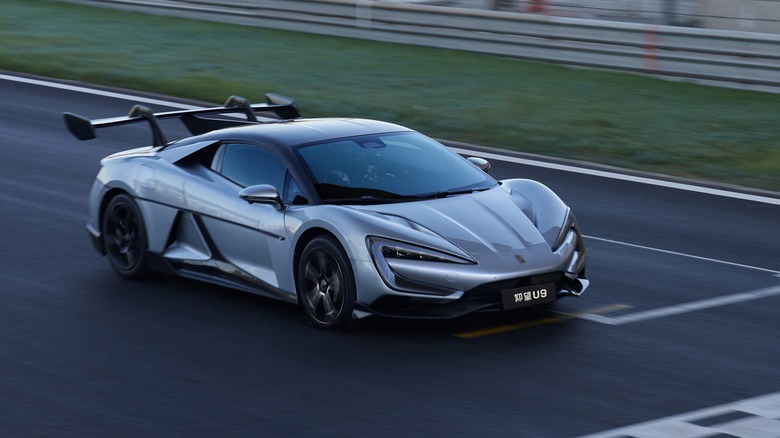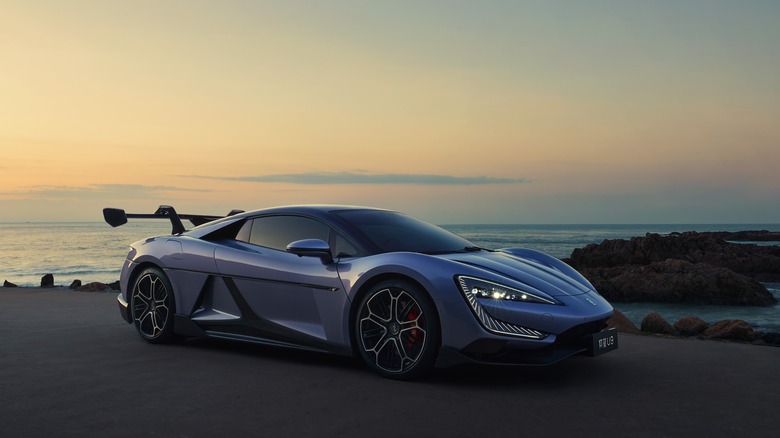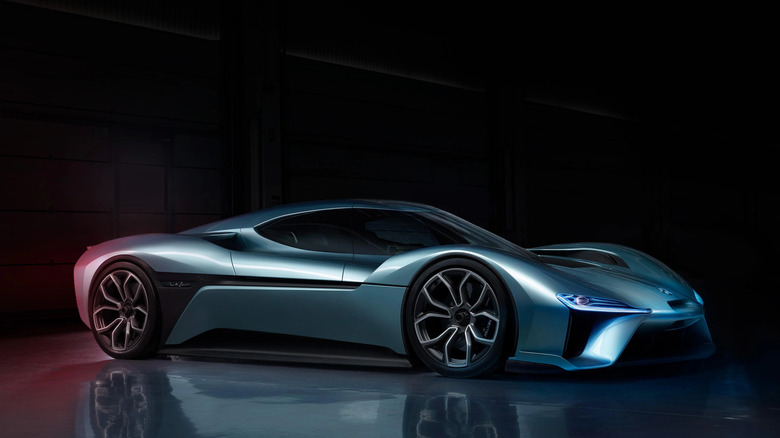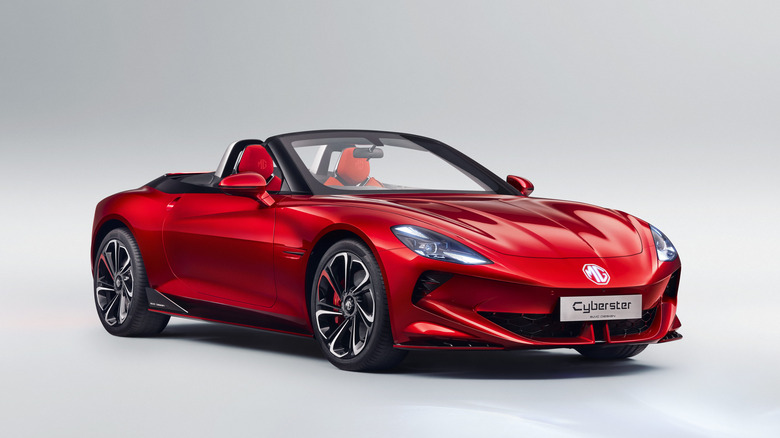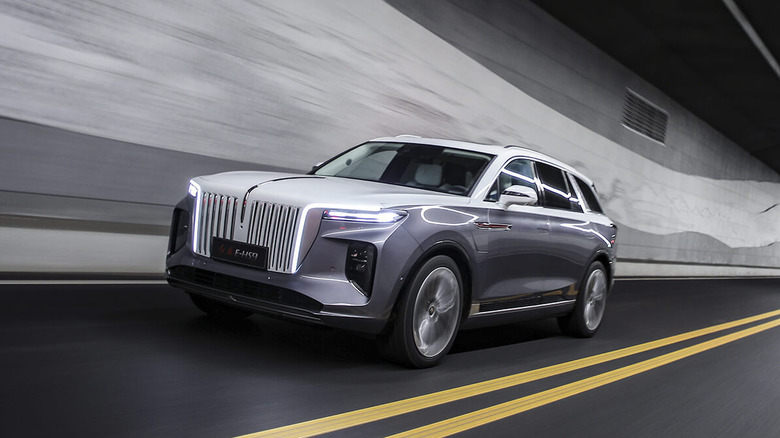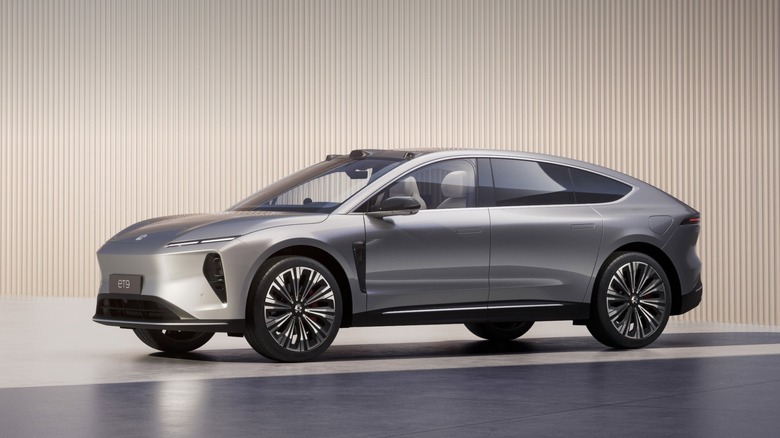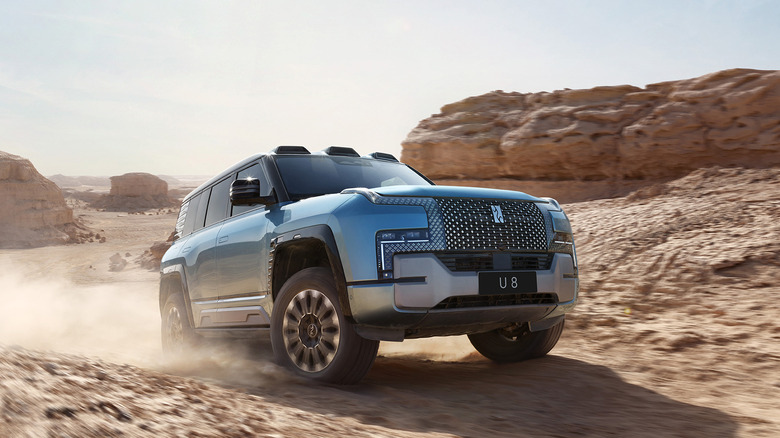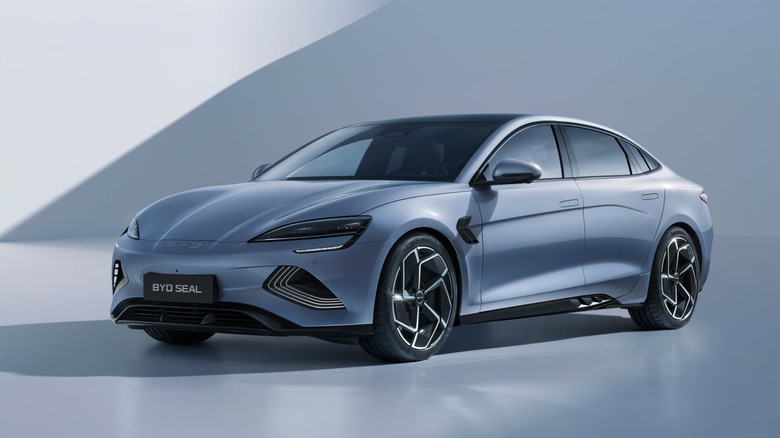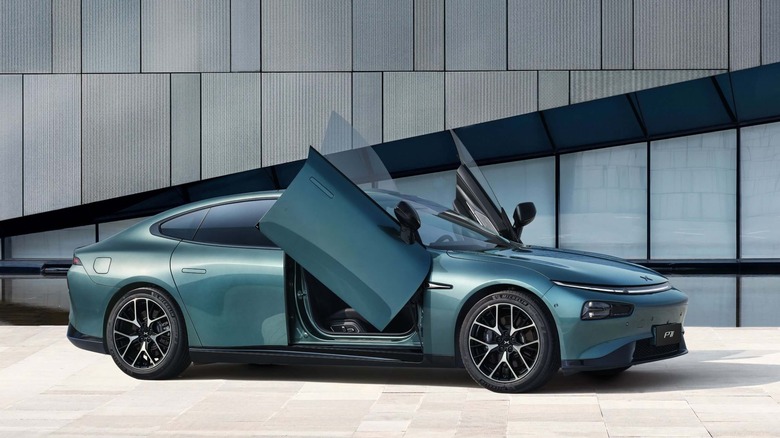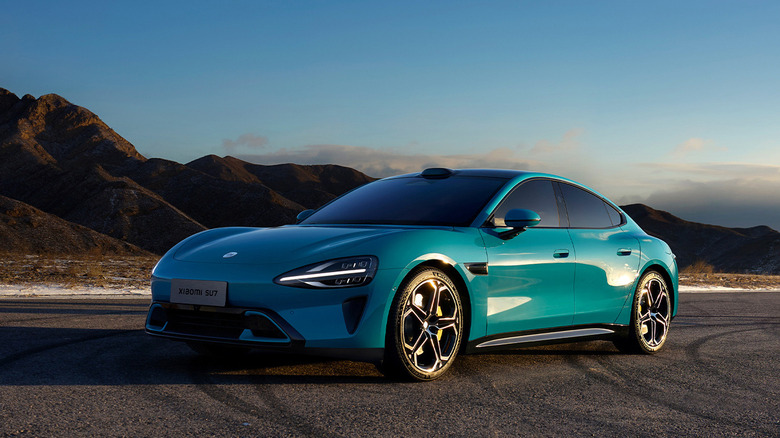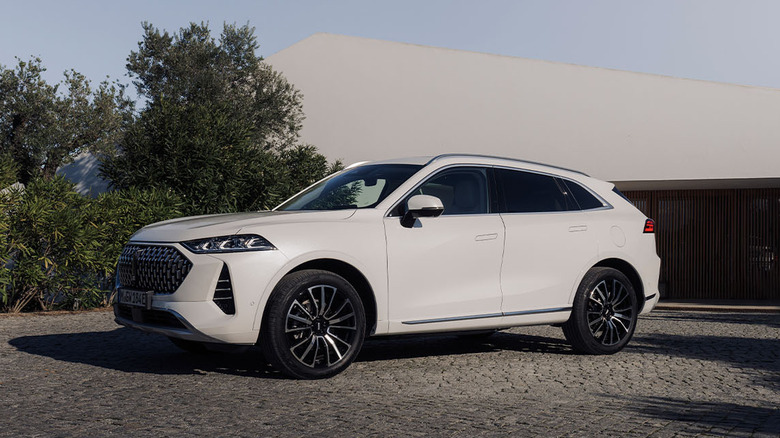10 Of The Coolest Chinese Cars You'll Wish Were Sold In The US
What are your thoughts on the Chinese automotive industry? Are you still imagining copycat cars with dated technology and questionable safety? Well, all these things were true until a few years ago, and frankly, Chinese manufacturers were rightfully ridiculed for their approach. Chinese cars were simply not good up until five years ago.
But things have changed in recent years — big time! Not only have Chinese automakers started implementing their own signature designs, but they have also started innovating. In some cases, they have even surpassed their established rivals, making big waves in the industry. That's particularly true in electrification, where China has the edge over other countries.
Still not a believer? Well, brace yourself because we are about to change your opinion. In this article, you'll be presented with the coolest Chinese cars that you wish were available in the U.S., and it doesn't matter whether you are captivated by design, tech, or performance because this list has it all. So, from blistering supercars to overpowering off-roaders, here is your A-Z on slick Chinese cars!
BYD Yangwang U9
The BYD Yangwang U9 is the perfect example of China's current automotive engineering prowess. A quad-motor all-electric hypercar, the U9 shows that electricity has its place in high-performance machines. Sure, Rimac beat BYD to the chase with the Nevera, but the Chinese company's premium brand flagship is barely more than one tenth the cost, starting at just $232,000 in China.
This is one of the most advanced automobiles in the world — at least on paper. As part of the advanced e4 Platform, the U9 has four motors at each wheel, producing 1,300 hp and 1,239 lb-ft of torque combined, resulting in a 0-62 mph time of brisk 2.36 seconds and a top speed of 192 mph.
Now, you must be thinking that the U9 is a one-trick pony, but BYD's DiSus-X Intelligent Body Control System is even more groundbreaking than the powertrain. It's a state-of-the-art adjustable suspension that can adjust the travel by 75mm, with a peak single-axis lifting speed of 500 millimeters per second. As a result, the car will stay flat when cornering, accelerating, or braking. Your $200k will also get you some gimmicks — the Yangwang U9 can also jump off the ground and drive with a missing wheel.
You may not be convinced by electric hypercars, let alone Chinese ones, but to dismiss the Yangwang U9 is a fool's errand. It shows that the Chinese automotive industry has matured, and it looks seriously cool!
NIO EP9
Wait — is that another hypercar? You bet it is! This one was launched in 2016 and tried to be the Tesla of supercars. It also broke the Nürburgring Nordschleife lap record in 2017 (06:45.900). The EP9 looks even better than the Yangwang U9, but the coolest part about the EP9 is that it's made by NIO, a brand that competes in the Formula E series. These guys are obviously crazy about competing, and the EP9 reflects that perfectly.
Much like the U9, it has four electric motors at each wheel, producing 1,341 hp and 1,091 lb-ft of torque combined. As a result, it reaches 124 mph in just 7.1 seconds and has a top speed of 195 mph. Not impressed by the latter figure? You should be, because the EP9 produces a staggering 24,019 newtons of downforce — double that of an F1 car! To go that fast with this figure requires some serious aerodynamic engineering, like 170-plus rounds of computational fluid dynamics. In addition, the EP9 has an active rear wing with three positions, which looks pretty rad.
Driving the NIO EP9 must feel like flying a fighter jet because it creates 3.30 G under braking and 2.53 G during cornering. The finest point — you won't need to wait for the battery to charge, as it supports battery swapping that lasts only 8 minutes. Unfortunately, the EP9 costs $3 million and is a track-only machine.
MG Cyberster
Okay, okay, China is in the hypercar game, but what about more down-to-earth sports cars available to the public? The MG Cyberster is a two-seat roadster that wants to compete with the Porsche 718 Boxster. And as far as design goes, it succeeds: It's an elegant yet sporty convertible that will surely turn heads everywhere it goes. Part of its charm is the Lambo-like scissor doors, which never ceased to be cool. However, in this case electric motors open them for you.
Gimmicks aside, the Cyberster wants to capture the spirit of MGB roadsters — yup, the British lightweight sports cars enthusiasts love. Only now, MG is a Chinese-owned brand, and as expected, it's electric, so it won't have the exhaust noise of its sports car competitors. It's also heavier than MG's roadsters of yore, weighing a staggering 4,850 pounds. Still, with a dual-motor, 496-hp powertrain, the Cyberster can reach 62 mph in just 3.2 seconds — quicker than a 718 Cayman GT4 RS!
Look, we don't suggest a Cyberster would be as fun to drive as any Porsche and we will get a 718 Cayman GT4 with a stick over it any day. But for the regular person, a quiet, cool-looking convertible that can smoke most cars at the traffic light is attractive. With a price of around $80,000 in the U.K., the dual-motor Cyberster is expensive (a single-motor variant is also available), but that's par for the course for EVs nowadays.
Hongqi E-HS9
Chinese automakers already have an answer for Rolls-Royce and Bentley, too. Hongqi, whose name means "Red Flag," is the most premium Chinese brand, tasked with producing President Xi Jinping's limo. However, the company also makes super-luxurious mass-market vehicles. Because people are crazy about luxury SUVs nowadays, we present to you its flagship SUV, the E-HS9.
This would be Hongqi's competitor to the Bentley Bentayga and Rolls-Royce Cullinan, only it's sold at Genesis and Lexus prices. The E-HS9 is truly a huge three-row SUV, measuring 205.08 inches long, and has an all-electric powertrain, yet it starts at $100,000 in the U.K. — it looks very commanding, too. Part of that is its sheer size, but the monolithic shape and authoritative front end certainly add to its appearance. The E-HS9 might be too imposing for some, but that's how wealthy people like their SUVs these days.
A quick peek inside the cabin of the E-HS9 shows where the money went. The dashboard is divided into three connected screens in the middle, one being for the front passenger, and there's a fourth screen below for the climate control. The screens don't dominate the cabin and are accompanied by carefully selected, nice-looking materials.
The E-HS9 can be equipped with up to a 120-kWh battery in the long-range model and a dual motor powertrain producing 544 hp. Hongqi promises a WLTP driving range of 320 miles, which is far from impressive but perhaps okay for an SUV that weighs a staggering 6,122 pounds.
NIO ET9
If you fancy an SUV, but want one of those coupe-style roofs, the ET9 might fit the bill. Nio's foray into the high-performance coupe-SUV category certainly catches the eye, with its fluid body lines leaving a better impression than the BMW X6. Put simply, its "landjet" design looks more sophisticated, especially when the height-adjustable air suspension is at its lowest setting.
However, the design is only the beginning, as the ET9 looks even more impressive on the inside. Inspired by private jets, NIO opted for a four-seat layout, allowing the two rear passengers enormous space, aided by the extra long 128-inch wheelbase. The rear seats can be reclined, and passengers can also mute the environment with a noise-canceling system. NIO went as far as putting 11 motorized shades — that's how serious the company was in creating the ultimate luxury crossover SUV. Large screens are everywhere, too; there is a 15.6-inch center one on the dashboard and twin 14.6-inch displays to entertain the rear passengers.
Still, all that pales in comparison to the industry-beating all-electric powertrain. The ET9 is the world's first 925-volt electric platform, which allows an astonishing 600-kW charging speed or a 158-mile range to be added after just five minutes of charging. If that wasn't enough, the ET9 also supports NIO's battery swap feature, which adds a full battery in less than five minutes. Furthermore, the dual-motor powertrain produces 697 hp, while the NIO Assisted & Intelligent Driving (NAD) and Navigate on Pilot Plus (NOP+) features provide you with semi-autonomous capabilities.
BYD Yangwang U8
As China's biggest automaker, BYD seems to tackle every possible category. We covered its supercar foray, now let's look at the company's attempt at crashing into the off-road world through its premium brand, Yangwang. The body-on-frame U8 is a 7,628-pound colossus that aims to beat the Mercedes-Benz G-Wagon at both off-roading and luxury.
It's no small feat, but at least on paper, the Yangwang U8 is already leading the pack in some areas. BYD opted for a plug-in hybrid powertrain, because EVs still don't make sense for off-road SUVs. In a vehicle like this, you might need to travel deep into the wilderness for days on end, and U8's PHEV powertrain with its 620-mile range certainly delivers.
Don't mistake the Yangwang U8 for the PHEVs we have in Western countries, though. With a sizeable 49-kWh battery, this mammoth SUV can go for 112 miles on electricity alone and then use a 268-hp, 2.0-liter turbocharged four-cylinder as a range extender. But the most impressive part is certainly the quad-motor, 1200-hp powertrain in the Premium Edition, which brings the U8 to 62 mph in just 3.6 seconds!
Because software controls each wheel, the quad-motor setup allows for some unparalleled off-road traction. The U8 can even turn by 360 degrees and float on water for up to 30 minutes! The Yangwang U8 is hi-tech inside, too, with numerous screens powered by an NVIDIA ADRIVE Orin processor that has a staggering computational capability of 508 TOPS.
BYD Seal
Clearly, China has no shortage of expensive and brash vehicles to offer, but their down-to-earth alternatives might be even more enticing. Take the BYD Seal as an example. A direct Tesla Model 3 competitor, the Seal promises excellent performance, long range, and advanced technology. It looks very streamlined and modern, with BYD apparently taking visual inspiration from the ocean.
Inside, BYD went with a less minimalist aesthetic, though the dashboard is still dominated by a huge 15.65-inch center display. Unlike the Model 3, the Seal also has a 10.25-inch instrument panel, which is certainly helpful. Overall, it doesn't look as polished as a Model 3, let alone a German premium sedan, and certainly less luxurious than its base $50,000 model in Europe would suggest.
Even so, the BYD Seal is backed by impressive numbers. The flagship model comes with an 82.5-kWh battery for a 354-mile range and a 523-hp dual-motor powertrain for a 0-62 mph time of 3.8 seconds. Furthermore, the CTB Blade Battery forms a strong sandwich structure with the body to increase its torsional rigidity. It's not all positive, though, as road tests show the Seal's AWD powertrain doesn't work well on snow-covered roads.
If you are not into EVs, BYD recently launched a PHEV variant called the Seal 06 DM-i. The PHEV model has a different design inside and out, but its highlight feature is the mind-blowing 1,305-mile range! The Seal 06 DM-I can go up to 75 miles on electricity alone and then use the 17.2-gallon gas tank.
Xpeng P7
Fancy a fast electric sedan with more panache than the BYD Seal? Have a look at the Xpeng P7, which for whatever reason has scissor front doors! Xpeng calls them X-wing doors, though they look nothing like the rebel starfighters from "Star Wars." Still, this is a list of cool vehicles, and the P7 definitely checks that box, especially since it also looks svelte even with the doors closed.
The P7 definitely looks better than the Seal inside, too, with an aesthetic that's a mishmash of BMW and Tesla. It's quite minimalist, with almost no buttons and two connected screens sitting on the decked dashboard. Those screens, along with the XPILOT 3.0 autonomous tech, are powered by a dual-chip computing system, which is a part of the Smart Electric Platform Architecture (SEPA). Crucially, MotorTrend said the P7 is built better than a Tesla!
Moreover, the P7 has the performance you'd expect from an electric sedan. The dual-motor version has 424 hp and 483 lb-ft, allowing it to reach 62 mph in just 4.5 seconds. The P7 is lighter than the Tesla Model S by 200 pounds, too, which is its most direct competitor. Choose the 263-hp RWD model, and the 80-kWh battery will give you a 329-mile range. That's good but far from impressive, especially when you consider it's on the more lenient WLTP cycle. However, keep in mind that the P9 costs less than the Model 3 in Europe despite being a Model S rival.
Xiaomi SU7
Apple has scrapped its long-rumored electric car project, but one of its biggest competitors globally, Xiaomi, already enjoys good market penetration with its first car, the SU7. This is not just any car — it's currently one of the most impressive EV sedans, with dreams of rivaling Porsche and Tesla. On the outside, it resembles a Porsche Taycan quite substantially. But the Taycan is a great-looking car, so why not copy it? Also, this body shape allows for an outstandingly low drag coefficient of 0.195, aiding with efficiency.
The cabin is rich with tech — not that you should expect anything less from a smartphone maker. The center console is dominated by a huge, rotating center touchscreen, but the more impressive tech is the 56-inch HUD powered by the "Showei" digital assistant — it even supports karaoke! The interior looks very luxurious, and Xiaomi even offers four color choices, including a cool Mist Purple trim. The body colors are very fun as well, with Xiaomi opting for a more vivid palette that includes Lava Orange, Radiant Purple, and Meteor Blue paints.
The Xiaomi SU7 becomes even more impressive once you look at the stats. Namely, the flagship model is built over an 800-volt architecture consisting of a 101-kWh battery and a 664-hp dual-motor powertrain. As a result, it can go an outstanding 503 miles on a single charge, reach 62 mph in 2.78 seconds, and add 317 miles of range with a 15-minute charge thanks to its HyperCharge feature.
GWM WEY 05
The GWM (Great Wall Motors) WEY 05 is another Chinese crossover SUV with impressive specs. It packs a plug-in hybrid powertrain but with an all-electric range of 91 miles on the WLTP cycle. The impressive range is the result of a fairly large 39.67-kWh battery, which is half of the size of the battery in a regular EV.
Unlike an EV, though, the WEY 05 is also ready for long journeys, thanks to a 2.0-liter four-cylinder turbo engine, which produces 201 hp on its own. The engine is connected to an electric motor and a nine-speed dual-clutch transmission via a clutch mechanism, and it drives the front wheels. However, there is also an electric motor at the back for full AWD capabilities. The system produces 476 hp and 625 lb-ft of torque combined, enough for a brisk 0-62 mph time of 5 seconds.
In creating a PHEV that has a long all-electric range and all the performance of an EV, GWM has already done what its international competitors failed to do — create a truly usable plug-in hybrid. The WEY 05 is an EV for most of the time, and a hybrid when you need extra range. It just makes sense. It's fairly luxurious, too.
The cabin looks plush and can be equipped with niceties such as Alcantara seats, Panoramic sunroof, multi-color ambient lighting, HUD with augmented reality, and an air purifier with PM2.5 detection. The WEY 05 also looks classy on the outside and is super safe, as confirmed by the five-star EuroNCAP rating.
